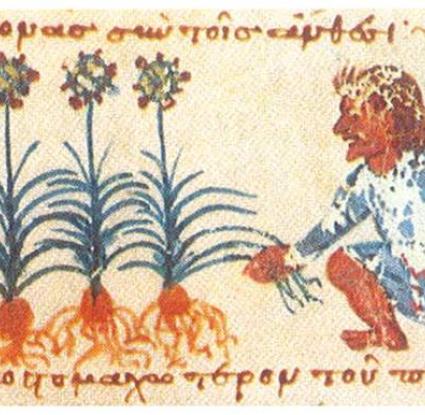Καλλιέργεια κήπου. Λεπτομέρεια μικρογραφίας χειρογράφου του 12ου αι. από τη Μονή Μεγίστης Λαύρας του Αγίου Όρους.J. Koder, 2005. "Η καθημερινή διατροφή στο Βυζάντιο με βάση τις πηγές", εικ. 7, σελ. 24. Στο Δ. Παπανικόλα-Μπακιρτζή (επιμ. έκδ.), Βυζαντινών Διατροφή και Μαγειρείαι. Αθήνα: Ταμείο Αρχαιολογικών Πόρων και Απαλλοτριώσεων.

Cabbage, krambí (cypriot), a type of vegetable.
Name - Origin
Cabbage, a vegetable with broad and fibrous leaves, twisted and compressed into a ball.
Scientific name: Brassica oleracea capitata.
Some vegetables, such as cabbage, were stored in basements or other suitable places without any particular preparation. The preservation of other vegetables was done through drying, for example, with legumes (Koder 2005, p. 23). Paul the Aeginite, a doctor of the 7th c. (Epitomae medicae libri septem, 9.1-9.2), vegetables were highly valued when preserved in vinegar and salt, like today's pickled vegetables (Koder 2005, p. 23).
Functional and symbolic role
According to Byzantine sources (Koukoules 1952, pp. 92-93), cabbage and other vegetables were cooked with various meats, with the addition of salt, oil, and also fat. It is also mentioned that cabbage was consumed either as an ingredient of monokythros with buffalo cheese or as a pickle (in brine or vinegar).
According to F. Koukoules (1952, p. 93), the proverb mentioned by Vasilios the Great (P.G. 32, 664) "through cabbage death", possibly comes from the fact that the physicians of the time believed that cabbage juice was harmful.
Additional information and bibliography
J. Koder, 2005. "Η καθημερινή διατροφή στο Βυζάντιο με βάση τις πηγές", σελ. 17-30. Στο Δ. Παπανικόλα-Μπακιρτζή (επιμ. έκδ.), Βυζαντινών Διατροφή και Μαγειρείαι. Αθήνα: Ταμείο Αρχαιολογικών Πόρων και Απαλλοτριώσεων.
F. Koukoules, 1952. Βυζαντινών Βίος και Πολιτισμός. Volume E. Athens.
Athanasios Vionis